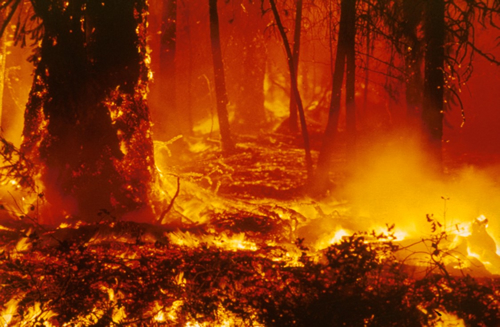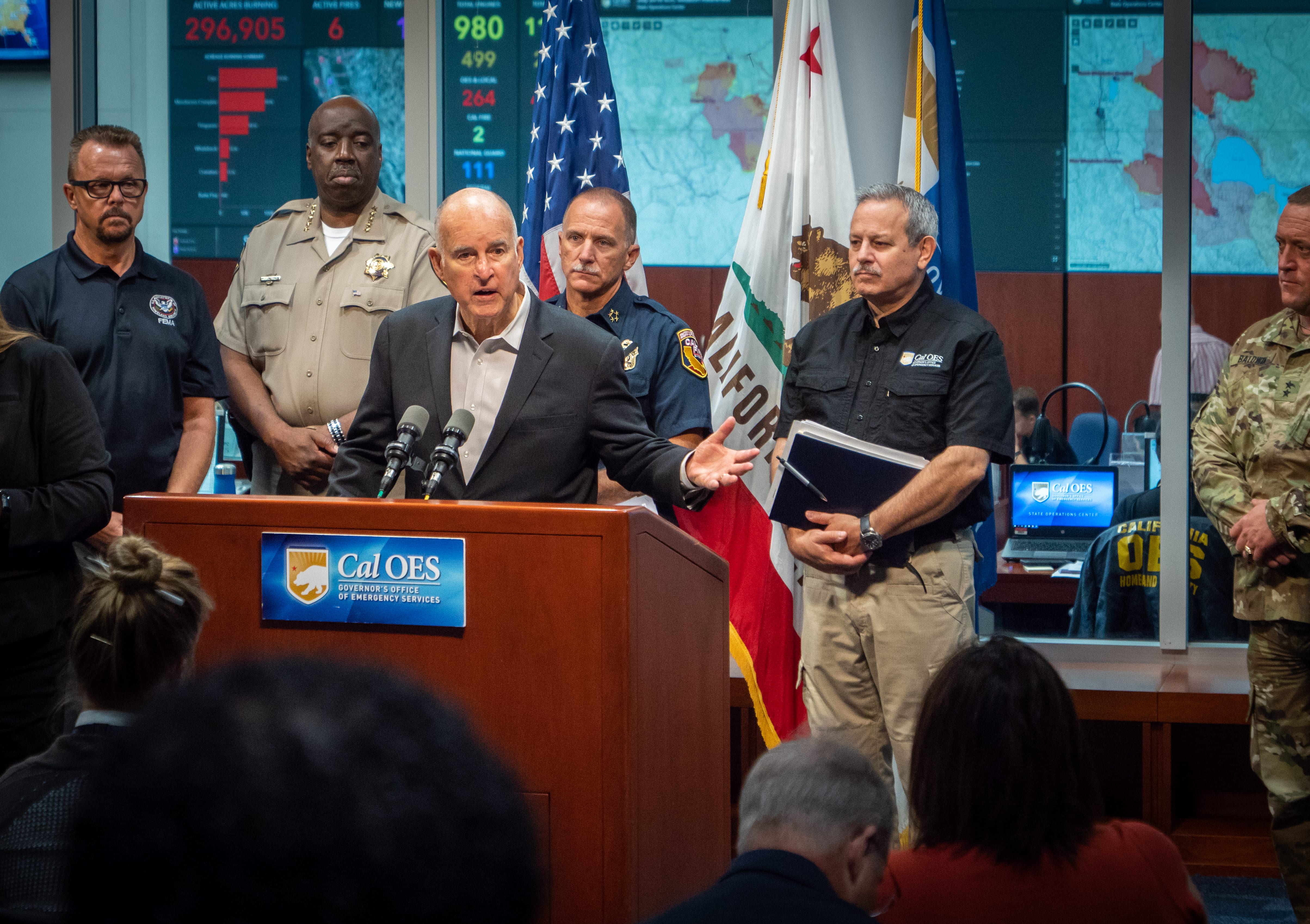
A wildfire in Northern California (Photo: USDA.gov)
Will Green Microgrids Reduce Deadly Fires and Brownouts?
State environmental policies imposed on the CPUC take precedence over public safety in the microgrid law
By Wayne Lusvardi, June 29, 2020 12:20 pm
92 percent of firestorms in California are not caused by downed power lines.
The California Public Utilities Commission by law restricts implementation of the safest, cheapest and fastest option of mobile natural gas power plants to lessen the risk of dropped power lines and provide backup power during any planned brownouts in California for the 2020 fire season. Given the fire risks and ineffectiveness of green microgrids, albeit legally mandated going into the 2020 fire season, green ideology codified into law takes precedence over public safety.
The CPUC is currently scrambling to install “microgrid” power plants in populated mountainous areas before the September 2020 fire season. The official reason is to prevent fires and brownouts resulting from downed power lines.
But 92 percent of firestorms in California are not caused by downed power lines (see “Why is California Blaming Wildfires on a Small Percentage of Downed Power Lines”?). And the insurance industry is increasingly concerned that installing small, fire prone, hybrid solar-battery power plants in high fire hazard areas will result in compound fire hazards.
The rush to install green microgrid power plants in high-forested and high-brush small communities in California comes from a June 11 CPUC Plan to lessen the impact of wildfires and power shutoffs due to preventative planned brownouts in highly-forested human populated areas.
In 2019, the CPUC relied on planned shutdowns of transmission line grids serving areas prone to wildfires. The many wildfires in 2018-19 resulted in Pacific Gas and Electric (PG&E), that serves the northern part of the state, to file for bankruptcy after incurring $13.5 billion in costs and liabilities related to the Camp Fire in Butte County. The Camp Fire was blamed on downed power lines. Firestorms cost $91 billion in costs all totaled in 2018-19.
SB 1339 Mandates Green Microgrids
The CPUC microgrid plan has to comply with California Senate Bill 1339 (2018 – Henry Stern, Democrat, Malibu), which mandates green microgrids under penalty of law over safer conventional natural gas mini-power plants. However, the law does allow natural gas-powered microgrids but only in the unlikely event it is already part of a localized power system (Sections 8371 & 8373).
Microgrids are a miniature power plant connected to a grid of solar-rooftop homes that electrifies a community’s electrical distribution system of power pole and buried power lines. A microgrid does not need to draw electricity from large regional transmission lines.
San Diego Gas and Electric (SDB&E) has already built a model hybrid diesel-solar microgrid in Borrego Springs in San Diego County financed with federal grants. The plant consists of:
- A diesel-powered generator, which emits high air pollution;
- A bank of PV-solar power panels;
- A flammable battery power substation and community lithium-ion battery structures the size of shipping containers;
- A coordination, dispatch center;
- All linked to 125-solar roof top homes that generate power back into the grid by reverse metering.
Noncompliance with the mandate for green microgrids is a crime.
Insurance Industry Concerns
However, according to Liberty Mutual Insurance Company, PV solar systems can not only cause fires but cannot be hardened against external fires, and once ignited are resistant to extinguishment.
While battery fires are infrequent, the insurance industry is concerned about rushing into installing residential battery-powered grids given the frequent fires from laptops, battery packs and e-cigarettes on jetliners, as well as Tesla car fires. In 2012, batteries storing electrons from an adjacent wind farm caught fire in Hawaii. Battery structures are flammable in a firestorm.
But mini natural gas-power plants can be hardened from firestorms. Firestorms are created by blast-furnace like winds that explode things in their path similar to incendiary bombs, but concrete structures are resilient.
Connecting the microgrid to residential rooftop solar systems is also risky. During the Paradise Fire in 2018, the firestorm leaped from home to home leaving trees untouched.
Nonetheless, flexibility for public safety is not much of an option in SB 1339 because noncompliance with the mandate for green microgrids is a crime (see Section 1). In other words, state environmental policies imposed on the CPUC take precedence over public safety in the microgrid law.
It was due to similar state mandates to defer maintenance on old natural gas lines to be phased out in California under green laws that resulted in the San Bruno gas pipeline that exploded in 2010, killing eight persons. Environmentalists used this “disaster waiting to happen” as legitimization for green power to replace natural gas. PG&E has been blamed for putting profits over safety but it is mis-prioritized government environmental policies that are behind their bad track record as to safety.
Too Late for Safer, Cheaper Mobile Nat Gas Power for 2020
When the Fukushima, Japan nuclear power plant was wrecked by the tsunami from the Tohoku earthquake in 2011, a chain of mobile gas turbine units was quickly interconnected to provide 135-megawatts of electricity for 135,000 households or 270,000 + people in Tokyo.
A gas-powered mobile turbine on eighteen-wheeler trucks can provide from 30 to 38 megawatts of power, enough to light up 30,000 to 38,000 homes (60,000 to 76,000 people) during temporary power losses. An in-place standby gas turbine can be generating power in six minutes. They have no visible emissions and low NOX emissions.
The Caterpillar Company advertises that it can deliver mobile natural gas power at a cost of $0.07 to $0.09 per kilowatt hour (kWh) depending on air temperature.
The average price of electricity in California, including 33% renewable energy, is $0.19 per kwh. Hybrid solar PV-battery systems cost $380 for four hours maximum generation ($95 kilowatt hour) and $895 per kilowatt hour for 0.5 hour of operation ($1,790 kilowatt hour). The capacity factor for natural gas is 24-hours/7-days per week/204-days a year (or 56 percent).
By law, the CPUC restricts implementation of the safest, cheapest and fastest option for mobile natural gas power plants to lessen the risk of dropped power lines and planned brownouts in California for the 2020 fire season.
Given the risks and ineffectiveness of green microgrids, albeit legally mandated, green ideology codified into law takes precedence over public safety.
- Peter Gleick’s National Water Plan for California - October 12, 2020
- Court Opens Up Big Prop.13 Loophole for ‘Public Franchise Fees’ - October 2, 2020
- New Cal Grid CEO is Ex-Enron Green Power Trader - September 29, 2020





Rural, mountain areas do not have natural gas for generators. My area is about 60 miles from the nearest gas line. We already have astronomical power rates, these plants will make electricity unaffordable. If we lose access to homeowners insurance, homes will become essentially worthless and people with home loans are going to be in big trouble.
The mountainous eastern sector of California is off the natural gas pipeline grid (see here) and would have to rely on Liquid Natural Gas (LNG) tanker trucks for delivery of gas and portable pipelines. LNG does not burn because it has no oxygen and is environmentally safe. LNG can be stored underground in its liquid state for safety but requires refrigeration. So, converting gas from its liquid state to its gaseous state for underground storage would be optimal.
Liquified natural gas is extremely energy intensive to liquify. If you ever have a breach in the storage you had better believe it will be flammable. The atmosphere has a lot of O2.
But LNG can be converted back to its gaseous form for storage. Probably still much cheaper than diesel/solar which has capacity of only 4 hours per day. Do you think your insurance is going to continue with only 4 hours of power/day?
Natural gas in its gaseous form is also highly flammable. The way these green fascists are going we will be lucky to have power for 4 hours a week. The old joke was “the last person to leave California, turn off the lights”. Our esteemed government is determined to turn the lights off with everyone still here.
A 3400 watt propane gas home or RV backup generator can be purchased at Amazon for $1,153 and costs $0.83 per kilowatt hour to operate. Champin 3400 Watt Dual Fuel RV Portable Generator with Electric Start. How any people in your county use propane now for heating or cooking?
Sure gas is flammable but we don’t have the number of nat gas residential fires that we see with firestorms, most of which are not caused by downed powerlines.
In my area we have had a major fire nearby every year for the last 10 years or more. None were caused by downed power lines.